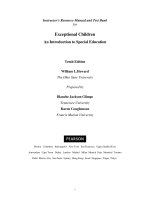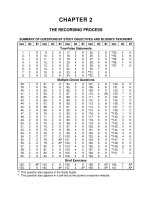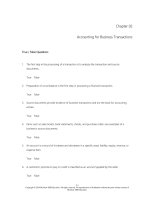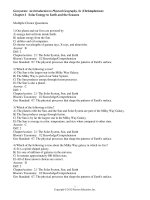Introduction to managerial accounting 6th edition brewer test bank
Bạn đang xem bản rút gọn của tài liệu. Xem và tải ngay bản đầy đủ của tài liệu tại đây (12 MB, 297 trang )
Chapter 02
Job-Order Costing
True / False Questions
1. The use of predetermined overhead rates in a job-order cost system makes it
possible to estimate the total cost of a given job as soon as production is completed.
True
False
2. A job cost sheet is used to accumulate costs charged to a job.
True
False
3. The following journal entry would be made to apply overhead cost to jobs in a joborder costing system:
True
False
4. Under a job-order cost system the Work in Process account is debited with the cost
of materials purchased.
True
False
5. The process of assigning overhead cost to jobs is known as overhead application.
True
False
6. The cost of a completed job in a job-order costing system typically consists of the
actual direct materials cost of the job, the actual direct labor cost of the job, and the
actual manufacturing overhead cost of the job.
True
False
7. A debit balance in the Manufacturing Overhead account at the end of the year
means that manufacturing overhead is overapplied.
True
False
8. Period costs are expensed as incurred, rather than going into the Work in Process
account.
True
False
9. Advertising costs should be charged to the Manufacturing Overhead account.
True
False
10. When a job has been completed, the goods are transferred from the production
department to the finished goods warehouse and the journal entry would include a
credit to Work in Process.
True
False
11. Underapplied or overapplied manufacturing overhead represents the difference
between actual overhead costs and applied overhead costs.
True
False
12. Top management salaries should not go into the Manufacturing Overhead account.
True
False
13. If manufacturing overhead applied exceeds the actual manufacturing overhead costs
of the period, then manufacturing overhead is overapplied.
True
False
Multiple Choice Questions
14. In computing its predetermined overhead rate, Marple Company inadvertently left its
indirect labor costs out of the computation. This oversight will cause:
A. Manufacturing Overhead to be overapplied.
B. the Cost of Goods Manufactured to be understated.
C. the debits to the Manufacturing Overhead account to be understated.
D. the ending balance in Work in Process to be overstated.
15. Which of the following is the correct formula to compute the predetermined
overhead rate?
A. Estimated total units in the allocation base divided by estimated total
manufacturing overhead costs.
B. Estimated total manufacturing overhead costs divided by estimated total units in
the allocation base.
C. Actual total manufacturing overhead costs divided by estimated total units in the
allocation base.
D. Estimated total manufacturing overhead costs divided by actual total units in the
allocation base.
16. Which of the following would probably be the least appropriate allocation base for
allocating overhead in a highly automated manufacturer of specialty valves?
A. machine-hours
B. power consumption
C. direct labor-hours
D. machine setups
17. What document is used to determine the actual amount of direct labor to record on
a job cost sheet?
A. time ticket
B. payroll register
C. production order
D. wages payable account
18. A proper journal entry to close overapplied manufacturing overhead to Cost of
Goods Sold would be:
A. Option A
B. Option B
C. Option C
D. Option D
19. In a job-order costing system, direct labor cost is ordinarily debited to:
A. Manufacturing Overhead.
B. Cost of Goods Sold.
C. Finished Goods.
D. Work in Process.
20. In a job-order costing system, the use of direct materials that have been previously
purchased is recorded as a debit to:
A. Raw Materials inventory.
B. Work in Process inventory.
C. Finished Goods inventory.
D. Manufacturing Overhead.
21. The journal entry to record the incurrence of indirect labor costs is:
A. Option A
B. Option B
C. Option C
D. Option D
22. Which of the following accounts is debited when direct labor is recorded?
A. Work in process
B. Salaries and wages expense
C. Salaries and wages payable
D. Manufacturing overhead
23. The balance in the Work in Process account equals:
A. the balance in the Finished Goods inventory account.
B. the balance in the Cost of Goods Sold account.
C. the balances on the job cost sheets of uncompleted jobs.
D. the balance in the Manufacturing Overhead account.
24. In a job-order costing system, indirect materials that have been previously purchased
and that are used in production are recorded as a debit to:
A. Work in Process inventory.
B. Manufacturing Overhead.
C. Finished Goods inventory.
D. Raw Materials inventory.
25. Martinez Aerospace Company uses a job-order costing system. The direct materials
for Job #045391 were purchased in July and put into production in August. The job
was not completed by the end of August. At the end of August, in what account
would the direct material cost assigned to Job #045391 be located?
A. raw materials inventory
B. work in process inventory
C. finished goods inventory
D. cost of goods manufactured
26. Which terms will make the following statement true? When manufacturing overhead
is overapplied, the Manufacturing Overhead account has a __________ balance and
applied manufacturing overhead is greater than __________ manufacturing overhead.
A. debit, actual
B. credit, actual
C. debit, estimated
D. credit, estimated
27. Overapplied manufacturing overhead occurs when:
A. applied overhead exceeds actual overhead.
B. applied overhead exceeds estimated overhead.
C. actual overhead exceeds estimated overhead.
D. budgeted overhead exceeds actual overhead.
28. Daguio Corporation uses direct labor-hours in its predetermined overhead rate. At
the beginning of the year, the total estimated manufacturing overhead was $224,580.
At the end of the year, actual direct labor-hours for the year were 18,200 hours,
manufacturing overhead for the year was underapplied by $12,100, and the actual
manufacturing overhead was $219,580. The predetermined overhead rate for the year
must have been closest to:
A. $11.40 per machine-hour
B. $12.34 per machine-hour
C. $12.06 per machine-hour
D. $10.53 per machine-hour
29. Wert Corporation uses a predetermined overhead rate based on direct labor cost to
apply manufacturing overhead to jobs. Last year, the company's estimated
manufacturing overhead was $1,200,000 and its estimated level of activity was 50,000
direct labor-hours. The company's direct labor wage rate is $12 per hour. Actual
manufacturing overhead amounted to $1,240,000, with actual direct labor cost of
$650,000. For the year, manufacturing overhead was:
A. overapplied by $60,000
B. underapplied by $60,000
C. overapplied by $40,000
D. underapplied by $44,000
30. Crinks Corporation uses direct labor-hours in its predetermined overhead rate. At the
beginning of the year, the estimated direct labor-hours were 11,200 hours and the
total estimated manufacturing overhead was $259,840. At the end of the year, actual
direct labor-hours for the year were 10,800 hours and the actual manufacturing
overhead for the year was $254,840. Overhead at the end of the year was:
A. $4,280 overapplied
B. $9,280 overapplied
C. $9,280 underapplied
D. $4,280 underapplied
31. At the beginning of the year, manufacturing overhead for the year was estimated to
be $267,500. At the end of the year, actual direct labor-hours for the year were
22,100 hours, the actual manufacturing overhead for the year was $262,500, and
manufacturing overhead for the year was overapplied by $13,750. If the
predetermined overhead rate is based on direct labor-hours, then the estimated
direct labor-hours at the beginning of the year used in the predetermined overhead
rate must have been:
A. 22,100 direct labor-hours
B. 19,900 direct labor-hours
C. 21,000 direct labor-hours
D. 21,400 direct labor-hours
32. Brace Corporation uses direct labor-hours in its predetermined overhead rate. At the
beginning of the year, the estimated direct labor-hours were 21,600 hours. At the end
of the year, actual direct labor-hours for the year were 20,400 hours, the actual
manufacturing overhead for the year was $506,920, and manufacturing overhead for
the year was underapplied by $23,440. The estimated manufacturing overhead at the
beginning of the year used in the predetermined overhead rate must have been:
A. $501,920
B. $531,445
C. $483,480
D. $511,920
33. Yista Corporation uses a predetermined overhead rate based on direct labor-hours to
apply manufacturing overhead to jobs. The company estimated manufacturing
overhead at $510,000 for the year and direct labor-hours at 100,000 hours. Actual
manufacturing overhead costs incurred during the year totaled $540,000. Actual
direct labor-hours were 105,000. What was the overapplied or underapplied overhead
for the year?
A. $30,000 overapplied
B. $30,000 underapplied
C. $4,500 overapplied
D. $4,500 underapplied
34. Malcolm Company uses a predetermined overhead rate based on direct labor-hours
to apply manufacturing overhead to jobs.
The cost records for September will show:
A. Overapplied manufacturing overhead of $1,500
B. Underapplied overhead of $1,500
C. Overapplied manufacturing overhead of $3,500
D. Underapplied overhead of $3,500
35. The Work in Process inventory account of a manufacturing firm shows a balance of
$3,000 at the end of an accounting period. The job cost sheets of two uncompleted
jobs show charges of $500 and $300 for direct materials, and charges of $400 and
$600 for direct labor. From this information, it appears that the company is using a
predetermined overhead rate, as a percentage of direct labor costs, of:
A. 83%
B. 120%
C. 40%
D. 300%
36. Washtenaw Corporation uses a job-order costing system. The following data are for
last year:
Washtenaw applies overhead using a predetermined rate based on direct laborhours. What predetermined overhead rate was used last year?
A. $3.55 per direct labor-hour
B. $3.25 per direct labor-hour
C. $3.08 per direct labor-hour
D. $3.36 per direct labor-hour
37. Capalbo Corporation bases its predetermined overhead rate on the estimated laborhours for the upcoming year. At the beginning of the most recently completed year,
the company estimated the labor-hours for the upcoming year at 52,000 labor-hours.
The estimated variable manufacturing overhead was $2.78 per labor-hour and the
estimated total fixed manufacturing overhead was $1,192,360. The actual labor-hours
for the year turned out to be 52,600 labor-hours. The predetermined overhead rate
for the recently completed year was closest to:
A. $2.78
B. $25.45
C. $25.71
D. $22.93
38. Compton Company uses a predetermined overhead rate in applying overhead to
production orders on a labor cost basis in Department A and on a machine-hours
basis in Department B. At the beginning of the most recently completed year, the
company made the following estimates:
What predetermined overhead rate would be used in Department A and Department
B, respectively?
A. 83% and $5
B. 83% and $3
C. 120% and $3
D. 83% and $4
39. Hayne Corporation bases its predetermined overhead rate on the estimated
machine-hours for the upcoming year. Data for the most recently completed year
appear below:
The predetermined overhead rate for the recently completed year was closest to:
A. $7.89
B. $30.95
C. $24.52
D. $32.41
40. The Collins Company uses predetermined overhead rates to apply manufacturing
overhead to jobs. The predetermined overhead rate is based on labor cost in Dept. A
and machine-hours in Dept. B. At the beginning of the year, the company made the
following estimates:
What predetermined overhead rates would be used in Dept A and Dept B,
respectively?
A. 71% and $4.00
B. 140% and $4.00
C. 140% and $4.80
D. 71% and $4.80
41. Simoneaux Corporation bases its predetermined overhead rate on the estimated
machine-hours for the upcoming year. At the beginning of the most recently
completed year, the company estimated the machine-hours for the upcoming year at
22,000 machine-hours. The estimated variable manufacturing overhead was $8.65
per machine-hour and the estimated total fixed manufacturing overhead was
$609,400. The predetermined overhead rate for the recently completed year was
closest to:
A. $36.35 per machine-hour
B. $27.70 per machine-hour
C. $33.32 per machine-hour
D. $8.65 per machine-hour
42. Kelsh Company uses a predetermined overhead rate based on machine-hours to
apply manufacturing overhead to jobs. The company has provided the following
estimated costs for next year:
Kelsh estimates that 5,000 direct labor-hours and 10,000 machine-hours will be
worked during the year. The predetermined overhead rate per hour will be:
A. $6.80
B. $6.40
C. $3.40
D. $8.20
43. Kaiser Corporation bases its predetermined overhead rate on the estimated machinehours for the upcoming year. Data for the upcoming year appear below:
The predetermined overhead rate for the recently completed year was closest to:
A. $6.68
B. $25.02
C. $25.59
D. $18.34
44. The following data have been recorded for recently completed Job 674 on its job
cost sheet. Direct materials cost was $2,039. A total of 32 direct labor-hours and 175
machine-hours were worked on the job. The direct labor wage rate is $14 per laborhour. The company applies manufacturing overhead on the basis of machine-hours.
The predetermined overhead rate is $15 per machine-hour. The total cost for the job
on its job cost sheet would be:
A. $2,967
B. $2,487
C. $2,068
D. $5,112
45. Job 731 was recently completed. The following data have been recorded on its job
cost sheet:
The company applies manufacturing overhead on the basis of machine-hours. The
predetermined overhead rate is $14 per machine-hour. The total cost that would be
recorded on the job cost sheet for Job 731 would be:
A. $3,288
B. $5,094
C. $4,254
D. $2,418
46. The operations of the Kerry Company resulted in underapplied overhead of $5,000.
The entry to close out this balance to Cost of Goods Sold and the effect of the
underapplied overhead on Cost of Goods Sold would be:
A. Option A
B. Option B
C. Option C
D. Option D
47. Reichelderfer Corporation has provided data concerning the company's
Manufacturing Overhead account for the month of August. Prior to the closing of the
overapplied or underapplied balance to Cost of Goods Sold, the total of the debits to
the Manufacturing Overhead account was $50,000 and the total of the credits to the
account was $72,000. Which of the following statements is true?
A. Manufacturing overhead transferred from Finished Goods to Cost of Goods Sold
during the month was $72,000.
B. Manufacturing overhead applied to Work in Process for the month was $50,000.
C. Actual manufacturing overhead for the month was $50,000.
D. Manufacturing overhead for the month was underapplied by $22,000.
48. Hults Corporation has provided data concerning the company's Manufacturing
Overhead account for the month of November. Prior to the closing of the
overapplied or underapplied balance to Cost of Goods Sold, the total of the debits to
the Manufacturing Overhead account was $75,000 and the total of the credits to the
account was $57,000. Which of the following statements is true?
A. Manufacturing overhead transferred from Finished Goods to Cost of Goods Sold
during the month was $75,000.
B. Actual manufacturing overhead incurred during the month was $57,000.
C. Manufacturing overhead applied to Work in Process for the month was $75,000.
D. Manufacturing overhead for the month was underapplied by $18,000.









